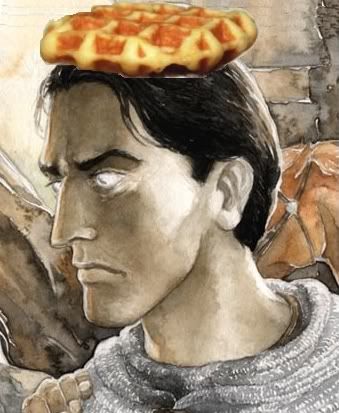This...is....my 300 review !!
Mood:
 on fire
on fire
YEAH baby! Finally!! 300 is out at last, and GLORYOSKI, is it ever spectacular.
We took in a Saturday matinee, at the local Shoebox 8. The movie theater was about ¼ full. (In this neck of the woods, that constitutes a sell-out crowd.) Brimming with anticipation, we bought tickets and happily settled into our seats.
Just as the movie began, a guy with an enormous firkin of popcorn arrived, scanned the acres of empty seats, then decided on the seat directly in front of me. He had a bushy gray mad-scientist hairdo that added about 6” to his height and blotted out the bottom edge of the screen. It was like watching the movie through shrubbery. I have just the worst seating karma. At the movies, I attract groups of 6’7”, fez-wearing basketball players with restless leg syndrome. On airplanes, I’m always sitting behind the one person who decides they must recline their seat alllllll the way back for a 45-minute flight. It’s not that I object to people wanting to stretch out – lord knows the airlines don’t give you much personal space – but I have long legs (34” inseam) and it’s a little distracting to have both kneecaps jammed askew for the duration of the flight. Airlines should offer “reclining” and “no reclining” sections.
Now, where were we? Oh, yes…300: the Hair Gone Wild edition.
LOVED it. For what it is, an adaptation of a graphic novel, it succeeds tremendously. Forget historical accuracy: Zach Snyder goes for the cartoonish exaggeration of mythology and oral tradition, and on that level, it’s a bull’s-eye. The cinematography is flat-out gorgeous. Most of the shots could be framed and hung in a museum. To name just a few favorite visual moments: The Oracle, writhing in a white nebula of shimmering gauze. The Spartans, knowing they’re about to die, huddled together in a dome formation with shields up, looking like a vulnerable, gilded tortoise. A beautiful aerial fresco of the 300 dead Spartans sprawled on the ground, pincushioned with arrows, deep in the eternal slumber of glory.
Composition and texture are stunning and sumptuous throughout, and exactingly faithful to the book. The landscape and sky of ‘300’ have a rich, creamy, golden haze like burnished armor, like a half-remembered dream. Against this backdrop the Spartan soldiers march to war, each soldier rendered with a gritty, hyper-real texture. Grainy close-ups reveal every pore, every speck of dirt, every drop of sweat. (‘300’ must look interesting in high-definition television.) The shields are pocked and dented; you can hear every dull clang of sword, every crunching footstep in the sand. War is the only tangible reality in the world of ‘300’. Everything else is just an abstraction.
Now, ordinarily I’m not a huge fan of war movies (or war, for that matter). Your average battle scene has a chaotic, numbing sameness. Once the armies clash, the screen is filled with quick cuts of yelling, grunting, mud, horses, explosions, shields, whacking swords, falling corpses. All you see are body parts. You’re never quite sure what’s going on. Who just got stabbed? Where’s the hero? Who’s this with the axe? Was that the bad guy or the good guy who got pulled off his horse? Which side is winning? Can we get on with the story? My eyes glaze over and I stop paying attention. (The male equivalent is sitting through a Jane Austen adaptation going “Man, this is boring. Where are the exploding helicopters and head kicks? Please…just one little car chase!”)
Well, there was no eye-glazing here. I was totally mesmerized. The battle scenes in 300 are utterly unique, unlike anything you’ve ever seen. When the Spartans hunker down into full phalanx formation and push against the oncoming waves of Persians, moving as one unit, you can feel the effort, taste the sweat – you’re right in there with them, taking cover behind the shields, desperately trying to maintain footing in the rocky dust, driving the enemy towards the cliffs on Leonidas' orders. When Stelios and Astinos break rank and go on a slo-mo balletic rampage through the Persian line, their murderous dance intoxicates you with the drunken grace and poetry of war. It’s preposterous, yet beautifully executed. The Spartans’ strength and discipline are obvious (as is the actors’ mastery of fight choreography). It becomes entirely plausible that with the Hot Gates at their backs, 300 Spartans might stand firm against wave after wave of poorly trained, poorly motivated slaves.
During the night battle, one amusing moment came when the Uber-Immortal cave troll thing fell on top of one of the Spartans. A dribble of yellow saliva came out of its mouth and landed on the Spartan’s face. Then the Uber-Immortal was stabbed through the mouth in a particularly heinous, gruesome, blood-splatting manner. The girl behind me exclaimed “Oh, gross! He DROOLED on that guy!” We got a chuckle out of that one.
The performances: great. Ahhh, Dilios….you complete me. David does a fabulous job of portraying Dilios with quiet intensity. I was sad that they cut most of his campfire storytelling scenes out of the movie, because then it would have been more clear why Leonidas singled him out to go tell the “grand tale” of the Spartans. It’s not like Leonidas can say “You have a special talent because…um….you’ve been narrating this film the whole time.”
Besides, those campfire stories provide some much-needed comic relief. In the book, I love the scene where Xerxes’ emissary arrives haughtily at the Spartan camp and finds Dilios in the midst of a story about the Olympics. Dilios completely ignores the huffy emissary, turning his back as he builds up to the punchline, “The Greeks know what is right…but only the Spartans do it!” In the film, the emissary is met instead by some indifferent wall-building Spartans. The trash-talking is amusing, but I miss the bonding, cheerleading, morale-building side of Dilios’ character.
This will sound blasphemously un-Spartan, but David looks totally cute in his bandage and scruffy hair and red cape, on top of looking smokingly hunky and ripped. You could say the rosary on his 8-pack (speaking of blasphemous…but hey, after seeing this film, I do believe in the resurrection of the body and abs everlasting). Strangely enough, David really does resemble book-Dilios. Not so much in looks -- book-Dilios is dark haired and rustic-looking, with chubby cheeks -- but in his mannerisms, his facial expressions, the way he sits, the way he ties the bandage over his eye, the way he walks and speaks with Leonidas. David inhabits the body of Dilios in the same hulkingly graceful way as his book counterpart, all broad shoulders and simian arms. I was absolutely blown away, considering the limited source material he had to work with. How on earth can he channel a cartoon character so convincingly?
As a nice bonus, Dilios gets a couple of lovely close-up hand shots. Happy happy joy joy, for all of us who think David has very sexy hands.
David’s narration is wonderful, with an authoritative soldier’s timbre tempered by the gentle lilt of recollection. At times, it almost sounds like a bedtime story being told to a circle of wide-eyed grandchildren, enhanced by a few little armored-rhino and elephant embellishments. It’s a testament to the self-effacing unity of the Spartans that Dilios isn’t tempted to make himself into the hero of the whole thing. There are a couple of moments where the comic-book style narration doesn’t quite translate to the screen. For example, when Leonidas is awaiting the verdict of the Oracle, suddenly Dilios is heard disdainfully muttering “Filthy, disease-ridden old men” (or something to that effect), and it sounds like Gerard Butler is having an internal monologue in David Wenham's voice. On the comic page, where Dilios can make editorial comments inside a little white box, it’s not so startling.
One small plot hole: the last encounter between Leonidas and Xerxes and the slaughter of the 300 occurs after Dilios gets sent away, so how does Dilios know the end of the story? One probably shouldn’t spend too much time worrying about it. Dilios is omniscient. Dilios knows all. He sees you when you’re sleeping. He knows when you’re awake.
There were one or two added visuals that made me go, “the fuh?”, such as the goat-headed clarinet player, the big Jabba-the-Hut dude with the bladed flipper forearms, and pretty much everything else going on in the Persian orgy scene. All the grotesque inbred deviance inside Xerxes’ tent makes it look like Leonidas is fighting, not just for freedom, but to keep all of Greece from being turned into a nightclub for pre-op transsexuals. As threats go, krumping in a mosh pit to Eiffel 65 seems like less of a horrible fate than, say, the total annihilation of democracy, but that’s just me.
Actually, ‘300’ has roiled up a lot of controversy for lumping together all the deformed, dark-skinned, and gay characters on the bad guys’ side. It’s a pretty simplistic (dare we say comic book?) view, not to be taken seriously, especially since it springs from the fevered imagination of Dilios. Although it is sort of fascinating to observe the hypocrisy of Frank Miller’s Spartans towards homosexuality. The major sin, apparently, is not being gay, but being weak and effeminate. Those “boy-loving” Athenians – they couldn’t fight their way out of a Gucci bag. (Snap, girlfriend!) Potters, bakers, and sculptors, masquerading as soldiers? Please. Androgynous Xerxes, with his multiple piercings and fishnet bling Speedo, never even sullies himself with fighting. His nakedness is all about displaying male eroticism; Leonidas’ nakedness is all about displaying male power. Even the Queen isn’t permitted to succeed on feminine terms. Having failed to sway Leonidas’ rival with the traditional arts of Venus, she must make her point to the Spartan council the old-fashioned, manly way, by stabbing Theron (who conveniently had the Persian gold concealed on him….do togas or codpieces have pockets?), then turning his own rape speech against him. That moment drew plenty of appreciative claps and whistles from the audience. In front of me, Hair Guy continued to munch his popcorn contentedly.
Xerxes’ Star Wars cantina party aside, I was also a little dubious about arming the Immortals with Molotov cocktails (or Tehran cocktails, if you like), a Tang dynasty invention that wouldn’t be used in warfare for another, oh, 900 years. There seems to be an ironclad law in Hollywood that all battles must contain explosions, no matter what the era. (“Kingdom of Heaven” has a protracted castle siege that looks like the firebombing of Dresden. I swear there’s some F-16s in one scene.) I must say, it did look very pretty, lighting up the screen with a brief fireworks display, but I had to actively stuff my disbelief back under the seat and tell it to be quiet. The sword and spear work stands on its own and doesn’t need stuff blowing up in the background. But, well, you know. Narrators.
At the end, Dilios has some huge and moving scenes. He’s the guy who brings news of the battle back to the queen, tells the story to the council, rallies the armies of Greece, and gives them the St. Crispin’s Day/Aragorn At The Black Gates speech. Wow, was he ever magnificent and commanding. I didn’t know David had that in him. (I did briefly wonder, when the camera pulled back to reveal 6 trillion troops packed into 17 miles of hillside, whether the people in the back might have had the teeniest difficulty hearing him. But they all roared “HA-OOO-AH!” on cue, so I guess not.) In the final moments, as Dilios charges towards the screen, with Greece at his back, you feel your heart soar. To victory! One of the most magnificent endings ever.
The animated end credits, inspired by images from the novel, are very cool too, and worth sticking around for. The flying blood – SPLOOSH! GERARD BUTLER…… SPLASH!! DAVID WENHAM – caused my companion to ask with bemusement, “Even the credits have to fling blood at us?”
“Oh, yes,” I said. “And it doesn’t end there. Warner Brothers employees are stationed outside the door of the theater right now, waiting to splatter us with blood as we leave. Like those perfume sample people who spritz you in department stores.”
“That reminds me….what’s for dinner?”
History does not record where we dined that night, but that afternoon, we dined in heaven. I think I shall be seeing ‘300’ a few more times.
Posted by dessicatedcoconut
at 5:41 PM EDT
Updated: March 12, 2007 6:05 PM EDT






